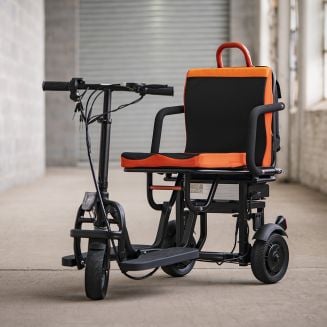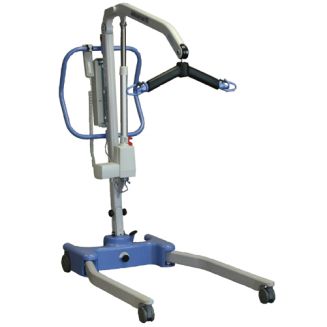Welcome to 1800Wheelchair.com Spring '19 Scholarship
Topic
Topic: Please submit a 'visual poem', in a style of your choosing, on the theme of overcoming a personal challenge.
Statement from 1800wheelchair
1800wheelchair is very proud to announce the winner of our Spring '19 scholarship contest. With well over 100 entries, this one stood apart for its positive energy, interesting visual and compelling story.
Winning Submission (Personal Statement): Strings
Before I begin, I’d like to introduce myself. My name is Morgan Stubblefield and I am a 20-year-old sophomore at Columbia College Chicago. I am a music major learning how to write, produce, record, and perform my own music. Singing has been my passion ever since I could talk and even though music is a risky career path, nothing will stop me from achieving my goals. The biggest personal challenge I faced this year was getting a diagnosis for Postural Orthostatic Tachycardia Syndrome (POTS).
In my poem, I describe myself as a puppet. The strings in the poem represent the symptoms of my disability: POTS. Because POTS does not always show visible symptoms, strangers around me assume that I’m not disabled or that I am faking my disability. I decided to use the puppet metaphor to represent people with invisible illnesses and disabilities. Often, if a person’s disability is not visible to the eye, they are dismissed and ignored. I wanted to bring light to invisible disabilities to show the world that not all disabled people “look” disabled.
This is represented in the lines:
My strings are invisible, only I know they’re there.
So, when I perform, others snarl and stare.
“You’re no puppet to me. You don’t know how it feels!”
But I’ve got strings attached, I promise they’re real.
To the human eye I look like a healthy 20-year-old girl, but I’m not. This is represented in the line: “I may look unchanged, but I promise I’m not.” To summarize, in the poem a puppet is a person with a disability and the strings represent the symptoms of that given disability. In the poem I say: “I perform nonetheless, there are some who believe. Because a puppet’s still a puppet with invisible strings.” This line basically states that I still identify with the disabled community despite having invisible symptoms. There are people who know invisible illnesses are valid and support me no matter what. Because I am disabled, no matter how invisible my symptoms are.
Even though I have a disability, the last line of the poem shows that I don’t let my disability hold me back. The poem states: “The twine may be strong, but I’m stronger than it. I am still my own person even though I’m a puppet.” This translates to, “My disability may be challenging at times, but I am strong and don’t allow my disability to overrun my life. I am still able to live life to the fullest even though I’m disabled.”
The biggest personal challenge I faced this year was getting a diagnosis for Postural Orthostatic Tachycardia Syndrome (POTS). About four months ago I was officially diagnosed with POTS, despite having severe symptoms for over a year.
During my last years of high school, I began experiencing POTS symptoms without even knowing it. I kept “getting up too fast,” according to the people around me. That meant, when I stood up I kept losing my eyesight and getting lightheaded. I pushed those symptoms aside until the summer going into my sophomore year of college. One morning I was hanging out with my sister in the living room when I decided to get myself a glass of water. I remember standing up from the couch, walking a few steps, and then waking up on the kitchen floor. When I stood up to get the glass of water, I began losing my eyesight which was normal for me. But this time those “small” symptoms lead to me fainting. I mentioned the incident to my doctor and she, like everyone else, told me I was just getting up too fast.
When my sophomore year of college began, my symptoms continued to escalate and become more severe. In late September, only a month into school, I stood up to sing and fainted again. From that day on, my symptoms became more apparent and worse. I was losing my eyesight and hearing when I stood 20+ times a day, sometimes when I stood my legs would give out and I would collapse to the floor, I was fatigued and lightheaded constantly. I decided to get a primary doctor near my college in Chicago and told her about my symptoms. One of the first things my new doctor suggested was that I had a condition called POTS, but she was not certified to diagnose that condition. She sent me to get several different tests and suggested I see a cardiologist for my elevated heart rate. I saw the cardiologist before getting any of the tests done and he completely ignored every word I said. Despite having a resting heartrate of 128 bpm (beats per minute) when he saw me, the cardiologist suggested it was all in my head and that I see a psychiatrist. He also tried to cancel all the tests my primary doctor had scheduled for me, but I stood up for myself and persisted something was wrong with me. The cardiologist was not the only doctor who didn’t believe me. Other nurses and doctors looked at me as if I was crazy, completely ignoring my symptoms and statements. In late January 2019, I was able to see a different cardiologist who immediately diagnosed me with POTS. He looked at all my test results and took my blood pressure and heart rate when I stood. The results were conclusive and I finally had a diagnosis to prove that my symptoms were real.
The biggest personal challenge I faced this year was getting a diagnosis for Postural Orthostatic Tachycardia Syndrome (POTS). About four months ago I was officially diagnosed with POTS, despite having severe symptoms for over a year.
I’ve overcome so many challenges, both physically and emotionally that one would think I would’ve given up years ago. That, however, was not the case. To all the people that told me I couldn’t, and the people that will now tell me I can’t, I wish you all the best and thank you for being the partial part of my motivation to push past my boundaries and becoming the person I am today. Without you, I wouldn’t have dared to say “WATCH ME” while you said “CAN’T”. I wouldn’t have continued to push my development and growth both mentally and physically, and for that I am extremely grateful.
I decided to use the puppet metaphor to represent invisible disabilities and all the people and professionals who ignore invisible symptoms. Because my symptoms are not visible to the eye, I was dismissed and mistreated despite feeling so ill. There was something wrong with me and the only people who believed me were my family and primary doctor in Chicago. It took so long for me to get a diagnosis which made it difficult for me to cope with my symptoms. When so many people are telling you, “you’re fine, it’s all in your head,” you start to believe them. But I kept fighting and never gave up until my invisible illness was recognized.
Winning Submission (Poem): Strings
Bound at my wrists, my ankles, and neck.
With locks of red hair; I’m a marionette.
My strings are invisible, only I know they’re there.
So, when I perform, others snarl and stare.
“You’re no puppet to me. You don’t know how it feels!”
But I’ve got strings attached, I promise they’re real.
Neglected, ignored, mistreated, forgot.
I may look unchanged, but I promise I’m not.
I’m a puppet, a doll; my strings add some weight.
You can’t see what’s there, but I still feel the strain.
I perform nonetheless, there are some who believe.
Because a puppet’s still a puppet with invisible strings.
The twine may be strong, but I’m stronger than it.
I am still my own person even though I’m a puppet.








